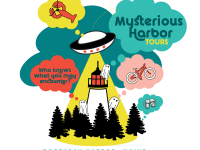Barry and Brenda headline WWI exhibit
Last week, I joined Barry Sherman, Jim Singer, and Phil Chapman on a quick trip to Augusta to view a small exhibit based on letters and artifacts from World War I.
Barry, a USMC Vietnam vet, loaned some of his family’s memorabilia for the exhibit in the Michael Klahr Center at the University of Maine, Augusta.
Barry asked us to go with him for a short ceremony. Of course, we agreed.
He is justly proud of his uncle’s service as a fighting Marine whose prowess earned him the high French medal called the “Croix du Guerre.”
David Greenham, the program director at the university’s Holocaust and Human Rights Center, told a small gathering how the letters from Sherman and others provided a unique link to the thought processes and feelings of the men caught up in the midst of what historians called “the Great War.”
In addition to the memorabilia, Greenham persuaded Barters Island artist Brenda Bettinson to provide context to the artifacts. And what a job she did, creating eight haunting portraits inspired by that conflict, which took place a hundred years ago.
I believe the star of the show is Bettinson’s ghostly tribute to Edith Cavell, a British nurse caught in Brussels when it was captured by German forces. Although a captive, she tended the wounded and, on the side, helped more than 200 British and French warriors escape. For her trouble, she was executed by a German firing squad.
The night before she died she showed no animosity towards her captors, telling an American chaplain: “Standing as I do in view of God and eternity: I realize that patriotism is not enough. I must have no hatred or bitterness towards anyone.” Remarkable last words from a hero.
Other Bettinson portraits show the twisted faces of German generals, worn out old men who sent young men to their doom. Others depict a wounded soldier in agony and a tribute to the post-war zeal of the German sailors who scuttled their ships rather than hand them over to their foes.
As she spoke of her work, Bettinson mentioned visiting the wide French agricultural area, watered by the Marne River, known for growing wine grapes and grain. One hundred years ago, massive armies slugged it out with massed artillery as soldiers crouched in deep trenches dreading the time when they would attack deadly machine gun nests.
It was the first modern use of what we now call weapons of mass destruction. Artillery shells filled with deadly poison gas filled the air and crept into the lowest depressions waiting for a soldier or Marine to neglect his primitive gas mask.
Barry Sherman remembered his uncle explaining the gas attack that made him feel his lungs were filled with broken glass.
Bettinson’s portrait turns gas-masked figures into fearsome aliens creeping through the poison mist.
As huge shells plowed up the battlefields, the river and its tributaries lost their banks turning fertile farmland into fetid mud. As men died, they were lined up in holes to be buried under the mud as shown by one of the Bettinson works.
And then, there were the horses.
In the days before jeeps and trucks and drones, much of the work of the armies on both sides was done with the help of horses.They carried packs. They pulled carts. They dragged huge guns through the miles of mud. They carried brave cavalrymen into the fire from the first modern machine guns. Horses and the men who urged them on and cared for them died by the thousands. All were shoved into pits and covered over.
Bettinson paid an iconic tribute to these four-legged victims in a split portrait evoking deep sadness.
Today, the French battlefields are once again lush agricultural land, home to the area known for the nation’s signature beverage, champagne.
You can tour the region by car, but I would love to experience it on a river barge floating past lands that show only a passing reference to the brutal sacrifice of war.
In most cases, few Americans other than U.S Marines, like Barry Sherman, recognize the names of picturesque villages like Château-Thierry. There the battling American Marines fought so hard the German high command supposedly asked: "Who are these Devil Dogs?"
But to Bettinson, an artist who grew up watching the German Air Force bomb London, the lush agricultural land was regenerated after being fertilized by the flesh and bones of thousands of brave men and their valiant four-legged companions.
Brenda Bettinson says her paintings are not for decoration. They are to communicate emotion and to give people focus — a chance to understand. And they do.
The World War I exhibit runs through Oct. 13.
Event Date
Address
United States

























